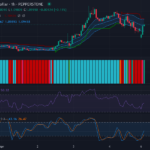
Trump’s Tough Trade Policies: No Deal with China Until the Deficit is Addressed
Tháng 4 6, 2025
Euro Vs US Dollar Analysis: Awaiting a Decisive Bullish Breakout – 07/04/2025
Tháng 4 6, 2025Recent Economic Challenges and Outlook for Japan: A Comprehensive Overview
Japan’s economy is currently navigating a turbulent landscape, as reflected in recent economic indicators and data. From household spending to wage growth, the nation is experiencing various economic dynamics that could have lasting implications for its recovery and overall financial health.
Decline in Household Spending
In February, Japan witnessed a 0.5% year-on-year decline in household spending, marking the first drop in three months. This downturn was significantly influenced by a notable 4.5% decrease in food expenditure. Such a dip in household spending raises concerns about consumer confidence, and it indicates that consumers may be tightening their belts in response to rising prices and inflationary pressures. This shift could lead to an extended period of reduced consumption, further exacerbating the fragile state of Japan’s economic recovery. As highlighted in discussions on economic trends, understanding consumer behavior is crucial during such times. For more insights, you can check out this blog.
Real Wages Under Pressure
The labor market also reflects challenging conditions, with real wages showing a downward trend. In February, real wages declined by 1.2% year-over-year, following a 1.8% drop in January. This continued decrease poses a significant concern for the purchasing power of households, particularly in a context where inflation is running above 3.7%—well above the Bank of Japan’s target of 2%. Consequently, with real wages declining alongside rising prices, many Japanese citizens may find themselves in a precarious financial situation. The implications of such trends align with the need for investors to assess economic conditions, as discussed in a recent blog about value investing.
Inflationary Pressures Persist
As inflation remains elevated at 3.7%, the Japanese economy faces pressures that complicate the prospect of recovery. Analysts from the International Monetary Fund (IMF) predict a gradual easing of inflation, estimating it will decrease to 2.4% by 2025. However, in the short term, the effects of high inflation can be detrimental to both consumer behavior and corporate profitability, which could hinder business investment and future growth opportunities. Investors are advised to be cautious and avoid common mistakes that could lead to losses during such economic fluctuations. For guidance, refer to this blog outlining investment mistakes to avoid.
Wage Growth Amid Economic Woes
Despite these economic challenges, there are signs of hope in the form of wage growth. In the recent “shunto” wage negotiations, companies offered average pay raises of 5.42%. This development signals a possible shift towards addressing the wage stagnation that has plagued Japan for decades, potentially giving consumers more spending power over time. The question remains whether these wage increases will be sufficient to offset the challenges posed by inflation and declining real wages.
Impacts of U.S. Tariffs and Long-term Economic Outlook
Another factor that looms over Japan’s economy is the potential impact of U.S. tariffs, particularly the 25% levy on Japanese car imports introduced by President Donald Trump’s administration. Economic forecasts suggest that such tariffs could diminish Japan’s GDP by as much as 2% over time, underlining the intertwined nature of global trade policies and domestic economic health. These dynamics highlight the importance of understanding global strategies and their effects on local markets, much like the strategic moves discussed in this blog about China’s response to U.S. tariffs.
In conclusion, while Japan’s economic recovery demonstrates pockets of resilience, it is also marked by significant challenges. The interplay of decreasing household spending, declining real wages, persistent inflation, and external pressures from international trade policy creates a complex economic environment. Policymakers and stakeholders must remain vigilant as they navigate these turbulent waters, adopting strategies that could foster a more stable and sustainable economic future.

